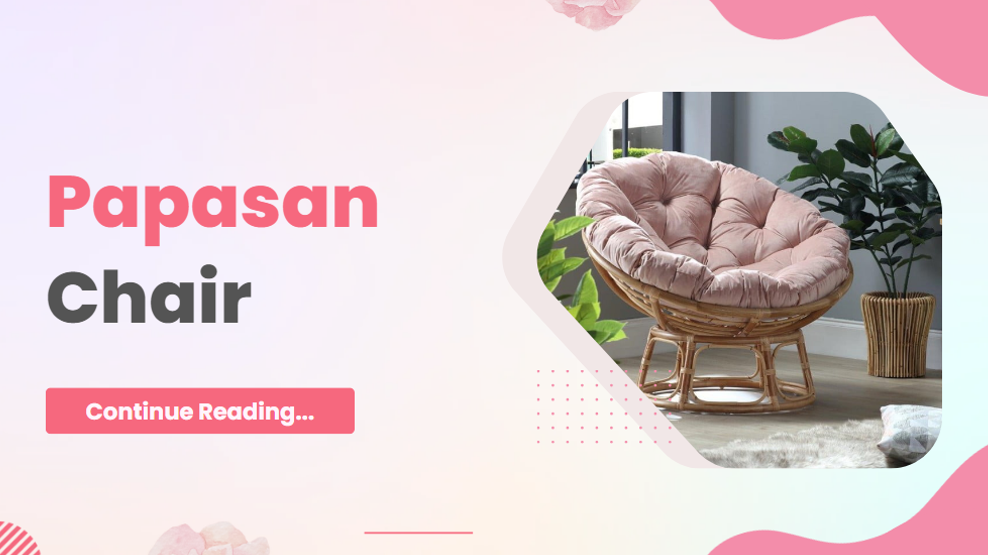

Archit Jain
Embracing Comfort: Discovering the Charm of the Papasan Chair
In a world of interior design, where functionality meets aesthetics, one piece of furniture stands out as the true embodiment of comfort and style – the Papasan chair. With its distinctive round shape, attractive cushioning and an interesting history that spans cultures, the Papasan chair has not only secured its place as a beloved icon in homes around the world, but also the admiration of design enthusiasts and comfort seekers has also won. In this in-depth exploration, we delve into the captivating allure of the Papasan chair, uncover its rich history, discuss its pros and cons, delve deep into its price range, and discover the myriad ways it can be used. integrate seamlessly into our daily lives.
A Historical Tapestry
To truly understand the allure of the Papasan chair, we have to travel back in time to its origins. The roots of the papasan chair can be found in the Philippines and other parts of Southeast Asia, where it originated from a fusion of tradition and craftsmanship. The word "papasan" itself is derived from the Malay word "papas", which means "to sit" or "to bow." This seating marvel was first crafted by skillfully weaving rattan or wicker into a bowl shape, providing unparalleled comfort to the occupant. Its design was both ergonomic and artistic, making it the epitome of functional beauty.
Pros: Exuding Comfort and Versatility
One of the most prominent advantages of the Papasan chair is its exceptional comfort. The bowl-shaped seat and plush cushioning provide a comfortable and inviting place to rest the body and relax. This comfort factor extends beyond physical sensations; It creates a mental and emotional escape, providing an escape from the stresses of daily life. The wraparound design of the Papasan chair is suitable for a variety of activities – reading, meditating, enjoying a cup of tea, or simply contemplating some time.
The versatility of the Papasan chair is another strong point. It transitions effortlessly between indoor and outdoor settings, making it the perfect piece for both a cozy living room and a serene garden corner. Its distinctive design can add a touch of bohemian charm to modern spaces or complement more traditional decor, showcasing its adaptability to a variety of design schemes.
Cons: Space and Mobility
Like any piece of furniture, the Papasan chair also has some drawbacks that need to be considered. One of the primary drawbacks is its size. The round shape of the chair can take up a lot of space, making it less suitable for compact living areas. Additionally, the unique design of the Papasan chair may not always integrate seamlessly with certain interior styles, potentially limiting its use in certain spaces.
Mobility is another factor that should be considered. While some modern versions come with a swiveling base, traditional Papasan chairs are stationary, which can be inconvenient if you need to move or rearrange the furniture frequently. This lack of mobility can be a downside for those who prefer flexible seating arrangements.
Daily Life Hug: Practical Uses
In the realm of daily life, the Papasan chair finds its place in various scenarios. It becomes a cozy corner in the living room, where you can take a good book or enjoy a fascinating conversation with loved ones. Situated near a window, it becomes a haven to daydream and gaze at the world beyond. In bedrooms, it can be transformed into a peaceful space for meditation or a makeshift workplace for those who seek inspiration in the comfort of their own home.
On outdoor patios or balconies, the papasan chair is an inviting sanctuary that allows you to enjoy the warmth of the sun while relaxing in comfort. It invites you to relax after a long day, encourages contemplation, and provides a unique vantage point from which to admire the beauty of nature.
Cultural Relations and Modern Adaptation
The allure of the Papasan chair goes beyond its physical features; It has cultural significance which adds to its attraction. Originating in Southeast Asia, this chair brings a piece of history and tradition into contemporary living spaces. It is a solid link to cultures that value both functionality and artistic expression in their creations.
Over the years, the Papasan chair has undergone modern adaptations, reflecting changing design sensibilities and preferences. While traditional materials like rattan remain popular, diversity in frame materials, cushion patterns, and colors has allowed this classic piece to evolve while maintaining its essence.
Considering the Price Range
While venturing into the realm of getting a papasan chair, price is an important factor to consider. The price range of Papasan chairs can vary greatly depending on factors such as material, craftsmanship, brand, and design intricacy. Traditional rattan or wicker papasan chairs may be more affordable, while chairs made from premium materials or with unique designs may be on the higher end of the spectrum. It is advised to explore the various options, do a thorough research and assess the value of the chair based on its longevity and the enjoyment it will bring to your living space.
Conclusion: A Cycle of Comfort
Ultimately, the Papasan chair wows us with its comfort and style. Its history, rich in craftsmanship and cultural resonance, adds depth to its appeal. Although it has notable advantages – comfort, versatility and a touch of tradition – it is important to weigh these with the disadvantages of space and mobility limitations. Yet, these drawbacks often pale in comparison to the enjoyment and comfort that the papasan chair provides to those who surrender to its alluring charms.
As we embrace the allure of the Papasan chair, we discover a space that is beyond mere seating - it is an area of rest, a place of reflection, and a testament to the creative fusion of form and function . Whether settled indoors or relaxing in the open air, the Papasana chair invites us to slow down, find solace in its contours, and embrace the sense of comfort that is our human desire for both physical and emotional well-being. closely matches with.

Archit Jain
Crafting Stories, One Word at a Time.
